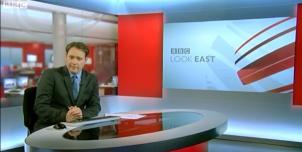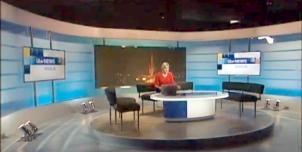Full Freeview on the Sandy Heath (Central Bedfordshire, England) transmitter
| Google Streetview | Google map | Bing map | Google Earth | 52.130,-0.242 or 52°7'47"N 0°14'33"W | SG19 2NH |
The symbol shows the location of the Sandy Heath (Central Bedfordshire, England) transmitter which serves 920,000 homes. The bright green areas shown where the signal from this transmitter is strong, dark green areas are poorer signals. Those parts shown in yellow may have interference on the same frequency from other masts.
This transmitter has no current reported problems
The BBC and Digital UK report there are no faults or engineering work on the Sandy Heath (Central Bedfordshire, England) transmitter._______
Digital television services are broadcast on a multiplexes (or Mux) where many stations occupy a single broadcast frequency, as shown below.
64QAM 8K 3/4 27.1Mb/s DVB-T MPEG2
H/V: aerial position (horizontal or vertical)
Which Freeview channels does the Sandy Heath transmitter broadcast?
If you have any kind of Freeview fault, follow this Freeview reset procedure first.Digital television services are broadcast on a multiplexes (or Mux) where many stations occupy a single broadcast frequency, as shown below.
64QAM 8K 3/4 27.1Mb/s DVB-T MPEG2
H/V: aerial position (horizontal or vertical)
Which BBC and ITV regional news can I watch from the Sandy Heath transmitter?

BBC Look East (West) 1.0m homes 3.7%
from Cambridge CB4 0WZ, 29km east-northeast (65°)
to BBC Cambridge region - 4 masts.
70% of BBC East (East) and BBC East (West) is shared output

ITV Anglia News 1.0m homes 3.7%
from Norwich NR1 3JG, 119km east-northeast (60°)
to ITV Anglia (West) region - 5 masts.
All of lunch, weekend and 80% evening news is shared with Anglia (East)
How will the Sandy Heath (Central Bedfordshire, England) transmission frequencies change over time?
| 1965-80s | 1984-97 | 1997-98 | 1998-2011 | 2011-13 | 12 Feb 2020 | ||||
| VHF | A K T | K T | K T | W T | W T | ||||
| C6 | ITVwaves | ||||||||
| C21 | C4waves | C4waves | C4waves | +BBCB | BBCB | ||||
| C24 | ITVwaves | ITVwaves | ITVwaves | D3+4 | D3+4 | ||||
| C27 | BBC2waves | BBC2waves | BBC2waves | BBCA | BBCA | ||||
| C31 | BBC1waves | BBC1waves | BBC1waves | ||||||
| C32 | com7 | ||||||||
| C33 | SDN | ||||||||
| C34 | com8 | ||||||||
| C35 | _local | ||||||||
| C36 | ArqA | ||||||||
| C39 | C5waves | C5waves | |||||||
| C43 | _local | ||||||||
| C48 | ArqB | ArqB | |||||||
| C51tv_off | SDN | ||||||||
| C52tv_off | ArqA | ||||||||
| C55tv_off | com7tv_off | ||||||||
| C56tv_off | COM8tv_off |
tv_off Being removed from Freeview (for 5G use) after November 2020 / June 2022 - more
Table shows multiplexes names see this article;
green background for transmission frequencies
Notes: + and - denote 166kHz offset; aerial group are shown as A B C/D E K W T
waves denotes analogue; digital switchover was 30 Mar 11 and 13 Apr 11.
How do the old analogue and currrent digital signal levels compare?
| Analogue 1-4 | 1000kW | |
| BBCA, D3+4, BBCB | (-7.4dB) 180kW | |
| SDN, ARQA, ARQB | (-7.7dB) 170kW | |
| com7 | (-13dB) 49.6kW | |
| com8 | (-13.1dB) 49.1kW | |
| Mux 1*, Mux 2*, Mux A*, Mux B*, Mux C*, Mux D* | (-17dB) 20kW | |
| Analogue 5 | (-20dB) 10kW |
Which companies have run the Channel 3 services in the Sandy Heath transmitter area
|
|
Thursday, 31 March 2011
S
Steve10:46 AM
Spalding
Am I right in thinking that someone who only uses Freeview from Sandy Heath won't have lost anything if they didn't retune yesterday? The new PSB1 has started, but the old MUX1 is still broadcasting, is this right?
| link to this comment |
Steve's: mapS's Freeview map terrainS's terrain plot wavesS's frequency data S's Freeview Detailed Coverage
S
Steve11:06 AM
Spalding
Ignore that previous post, suffering brain-fade.
| link to this comment |
Steve's: mapS's Freeview map terrainS's terrain plot wavesS's frequency data S's Freeview Detailed Coverage
M
Mrs L Hardy11:27 AM
Cannot get BBC1 or 2 after having retuned on main LoungeTV with outside aerial. Other TVs in house just on portable aerials work all except one in study on portable aerial. Main concern though is the Lounge modern upto date TV. what shall i do?
| link to this comment |
M
Mike Dimmick1:53 PM
Reading
Bain: Insulation does perish as the plasticizer chemical evaporates over time. If walls are damp that can allow water to get in, which changes the cable's behaviour. Generally you see some loss at low frequencies and higher losses as the frequency increases.
External cables are subject to wind, rain and UV light, which will usually make them wear out sooner.
For digital TV it's recommended that you use 'satellite grade' cable, which has a screen of dense braid over metal foil tape. The cable usually used for analogue TV tended to have a bare minimum of screening braid, which to be honest wasn't really sufficient to keep out electrical noise. Electrical noise on an analogue picture caused occasional bright lines. On a digital signal it causes errors, which - if there are enough of them - cause picture breakup and, rapidly, complete drop-out.
The longer the cable is, the more signal will be lost. Again, 'satellite grade' cable is intended to deal with very low signal levels and loses a lot less signal than so-called 'low-loss' coax.
| link to this comment |
Mike's: mapM's Freeview map terrainM's terrain plot wavesM's frequency data M's Freeview Detailed Coverage
M
Mike Dimmick1:55 PM
Reading
Mrs L Hardy: Can you provide a full postcode please?
If everything worked before switchover, there's a chance that signals are now too strong rather than too weak. If you have any amplifiers, try removing them, or turning down if it's adjustable. If that doesn't help, or there aren't any, try adding an attenuator.
| link to this comment |
Mike's: mapM's Freeview map terrainM's terrain plot wavesM's frequency data M's Freeview Detailed Coverage
R
Robert Robinson2:37 PM
hi
Have been receiving digital signals on BBC - ITV etc for the last 5 years - but have lost all BBC stations yesterday - I have a Samsung Digital Terrestrial receiver S1R-U200iinto an analogue Sony TV - I have retuned the receiver several times -no luck - is it a case of having a new TV or freeview box - thank you regards Robbie
| link to this comment |
B
Bain3:29 PM
Bedford
Mike: Thanks for the response. I would imagine that all the cables are coax rather than satellite grade, so that would probably explain the problem.
The issue now then I guess it the fact that all the cables are built into the walls and the loft floor, so replacing them is going to be a pretty big job.
| link to this comment |
Bain's: mapB's Freeview map terrainB's terrain plot wavesB's frequency data B's Freeview Detailed Coverage
M
Mike Dimmick4:26 PM
Robert Robinson: I'm afraid this box is on the list of 2K-only equipment at http://www.digitaluk.co.uk/2kequipment . It can't be fixed with a software upgrade. You'll need to get a new Freeview box.
The new multiplexes use an 8K mode which is more robust when reflections are picked up. It's also the mode that most other countries are using. We're fairly unique in ever having used 2K mode. New boxes should all support 2K and 8K modes. (RG47SH)
| link to this comment |
R
Richard11:38 PM
Until yesterday, I was able to receive all freeview channels I know of. Like Mrs L Hardy, yesterday I stopped being able to receive BBC1,2,3, but continued being able to receive channels on other multiplexes. I can currently receive a total of 90 channels, but no BBC1,2,3. I have a signal booster, but turning this off causes many other channels (eg, ITV1,2,3) to become unavailable, and doesn't bring BBC1,2,3 back (including after a rescan); without the booster on, I can still receive BBC 4, Film 4, Dave, etc (56 channels in total).
I'll try getting hold of an attenuator; hopefully the problem is that BBC1,2,3 are now too powerful, but the other channels which haven't been boosted yet are still too weak. Hopefully after the other channels are boosted, I'll just need an attenuator, and no longer need the booster.
| link to this comment |
Select more comments
Your comment please!




